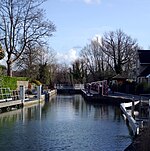Osney

Osney or Osney Island (; an earlier spelling of the name is Oseney) is a riverside community in the west of the city of Oxford, England. In modern times the name is applied to a community also known as Osney Town astride Botley Road, just west of the city's main railway station, on an island surrounded by the River Thames, Osney Ditch and another backwater connecting the Thames to Osney Ditch. Until the early 20th century the name was applied to the larger island of Oxford Castle and New Osney (between Castle Mill Stream and the main stream of the Thames) on which Osney Abbey and Osney Mill were established during the Middle Ages. The place plays a minor but significant role in The Miller's Tale in Chaucer's The Canterbury Tales.
Excerpt from the Wikipedia article Osney (License: CC BY-SA 3.0, Authors, Images).Osney
Bridge Street, Oxford Osney
Geographical coordinates (GPS) Address Website Nearby Places Show on map
Geographical coordinates (GPS)
| Latitude | Longitude |
|---|---|
| N 51.752 ° | E -1.274 ° |
Address
The Holly Bush
Bridge Street 106
OX2 0BD Oxford, Osney
England, United Kingdom
Open on Google Maps










